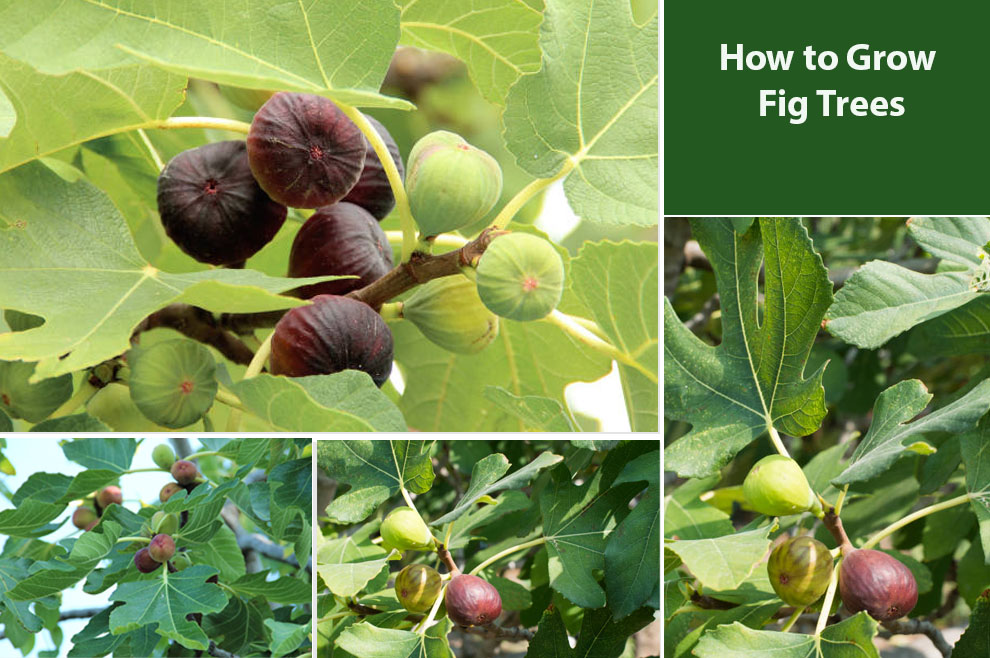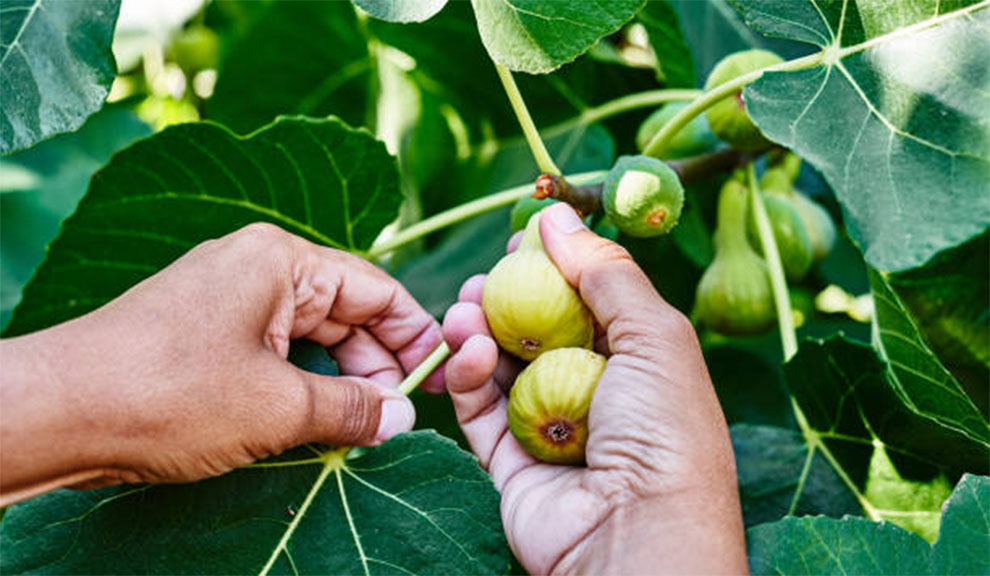How To Grow Figs: Planting Fig Trees At Home
Plant fig trees in well-drained soil, preferably in full sun. Water regularly, especially during the growing season, but fertilize sparingly. Prune in late winter to shape and remove dead branches.

Fig Trees or (Ficus carica) are an excellent addition to any garden. They offer nutritious and sweet fruit, lush foliage, and a touch of Mediterranean charm to any surrounding.
People are often interested in planting fig trees at home, courtesy of their astounding beauty. Fortunately, it is not difficult, provided you know some vital factors.
Firstly, ensure you plant the Figs in well-draining soil with ample sunlight, preferably in a spot sheltered from strong winds. Fig trees thrive in USDA hardiness zones eight through eleven.
You can also grow them in containers and shift them indoors in colder climates. Fortunately, the fig trees are adaptable and somewhat low-maintenance. However, you need to guard them against frost and prune timely for optimal growth and fruit production.
Whether you are an amateur new to the journey or a seasoned gardener interested in growing figs, this guide will help you. Continue reading as we discuss the process in detail below.
How To Grow Figs at Home – An Overview
| When to plant | Late winter to early spring |
| Where to plant | Full sun, well-draining soil |
| Hardiness zone | Varies by variety, typically 8-11 |
| Soil type & pH | Well-draining, pH 6.0-7.0 |
| Planting Depth | Level with the root ball |
| Watering | Consistently moist, not soggy |
| Spacing | 10-15 feet between trees |
You can grow fig trees at home by two primary methods – sowing seeds or propagating from cuttings.
A. Can you grow fig trees from seeds?
Yes, you sure can! Growing fig trees from seeds can be a rewarding but patience-testing endeavor. Here is a step-by-step guide:
1. Seed Collection: Pick the seeds from the ripe figs, clean them of any pulp, and then scarify the outer shell by gently sanding or nicking it.
2. Seed Soaking: Soak the scarified seeds in warm water for 24 hours to soften the seed coat.
3. Planting Medium: Prep a well-draining seed-starting mix by combining the potting soil and perlite or vermiculite in equal parts. Fill small trays or pots with this mix.
4. Planting: Plant the seeds approximately ¼ inch deep into the mix. Multiple seeds can go in each pot.
5. Optimal conditions: Move the pot to a well-lit, warm spot with temperatures around 70-75 °F (21-24°C).
6. Moisture Maintenance: Keep the soil consistently moist, but ensure it does not get overly saturated. Figs prefer moderate humidity. So, regularly mist the surface to maintain it.
7. Transplanting: When the seedlings grow multiple true leaves, transplant them into a larger pot with well-draining soil.
8. Harden Off and Plant Outdoors: Harden off the mature seedlings and pick a sunny outdoor location with well-draining soil to plant your fig tree.
9. Continued Fig Care: Water regularly and guard your plants against extreme cold in the first winter. Prune as needed to encourage optimal growth.
Of course, growing figs is a work of patience. However, nurturing your fig tree from its humble beginnings as seeds is gratifying.
B. How to plant fig trees from a cutting?
Growing figs from cuttings is an excellent propagation method to grow new trees holding the same characteristics as the parent plant. Here is the concise guide:
1. Pick a cutting: Opt for a disease-free, healthy branch from an existing fig tree. Ideally, the cuttings must be six to eight inches long and contain at least two nodes where the branches and leaves grow.
2. Prep the cutting: Remove the leaves from the cutting’s lower part. Alternatively, dip the cut end in the rooting hormone to encourage root development.
3. Planting Medium: Fill the pot with well-draining soil or mix with potting soil, vermiculite, and perlite.
4. Plant the Cutting: Insert this cutting approximately two to three inches deep into the soil, leaving one or two nodes above the surface.
5. Optimal Conditions: Move the pot to a well-lit, warm location, receiving temperatures around 70-75°F (21-24°C).
6. Maintain Moisture: Keep the soil consistently moist, not waterlogged.
7. Transplant: When the cutting develops roots and grows to a suitable size, transplant it into your garden. Alternatively, you can also grow them in a container.
By following the steps above, you can successfully propagate the fig trees from cuttings, preserving the desired characteristics of your chosen fig variety.
How To Grow Fig Trees – Consider These Things!
When it comes to growing fig trees, consider vital factors like suitable soil, spacing, and sunlight. These attributes have a significant role in the successful growth of your fig trees.
Let us delve into these crucial considerations in detail below.
A. Choosing the correct fig variety
Picking the correct fig species is imperative for successful fig cultivation, as different fig varieties have distinct flavors, adaptability to various climates, and growth habits. Here are some factors you must consider when picking a fig variety:
1. Location and climate: Always select a species suitable for the prevailing weather in your region. While some figs are cold-hardy, others can endure heat better.
2. Fruit usage and flavor: Pick a variety that matches your taste preference. Generally, fig varieties vary in flavor from mildly sweet to sweet and nutty.
Also, understand some kinds are ideal for fresh consumption, while others do better in dried form or as preserves. So, ensure the chosen species aligns with your preference and purpose.
3. Size and Color: You can find fig fruits in different sizes (small to large) and colors (brown, purple, green, or black when ripe). The color and size affect their appearance and flavor. So, pick one that serves your preferences and culinary use.
4. Production and Harvest Time: Some varieties produce a larger yield than others. So, when choosing the fig variety
consider what kind of harvest you expect.
Further, figs may have different ripening times, from early summer to late fall. Pick a species aligning with your local growing season.
5. Size and Growth Habit: Consider the space in your garden, and choose the variety accordingly, as some Figs are compact while others are suitable for small spaces. Also, some have a bushy habit, while others are more tree-like.
6. Disease Resistance: Ideally, you must go with a type resistant to the most prevalent fig disease.
7. Local Recommendations: If you cannot decide, seek recommendations from a local expert or nursery.
B. Where is the best place to plant fig trees?

Ideally, you must consider planting fig trees in a spot that receives at least six to eight hours of direct sun daily, has a slightly alkaline to neutral, well-draining soil, and is guarded against harsh winds.
Further, the spot must have good air circulation to avoid fungal diseases. Do not opt for low-lying areas with improper drainage.
Maintain ample space between trees and consider future growth and accessibility for care and harvesting. Speaking to a local expert for region-specific advice can help with the decision.
C. What is the best month to plant figs?
The best month for planting figs depends on your local climate. Generally, you can plant the fig trees in early spring or late winter, typically between February and April.
It lets the trees establish their roots before the hot summer months. In mild winter regions, late winter is the best time. For people from colder climates, planting in early spring following the last frost helps.
However, if you aspire for container-grown figs, you can grow them anytime around the year, ensuring the ground is not frozen. Account for the local frost dates and the typical weather patterns to determine the ideal planting time.
D. Do fig trees need full sun or shade?
Fig trees love full sun. Most fig varieties seek at least six to eight hours of direct sun daily for optimal growth and fruit production.
Of course, some figs can endure a little shade, primarily in hot weather, but they fail to develop their best flavor or produce well in such environments.
Thus, to achieve a productive fig tree, grow where it can bask in ample sun while guarding it against excessive heat, if necessary.
E. How much space do fig trees need?
Fig trees need 10 to 15 feet of space between each tree to accommodate their growth. This spacing ensures adequate room for their branches to develop and avoid overcrowding.
When planting fig trees near structures or other plants, account for their mature size and maintain clearance to prevent competition or shading.
Dwarf varieties can be spaced closer. However, leave at least a six to eight-foot gap between two plants. Container-grown species demand less space. So, you can leave a three to four feet gap between each.
Proper spacing helps with air circulation and encourages healthy growth. It also aids in long-life maintenance. Growth habits and local climate also influence spacing needs. So, consult your local expert if needed.
F. What soil is best for fig trees?
Fig trees prefer a well-draining, alkaline-neutral soil with abundant organic matter. The soil must have a pH between six and seven.
Loamy or sandy soils are best. They prevent root rot by ensuring proper drainage. Adding well-rotted manure or compost can help boost soil structure, nutrient content, and moisture retention.
Ensure the soil is deep enough to accommodate the extensive root system. Regular monitoring of nutrients, soil moisture, and mulching can help in optimal fig growth.
G. How often should I water a fig plant?
Fig plants seek regular watering, especially during the growing season, from spring to early fall. So, water deeply and consistently, ensuring the soil is reasonably moist.
The watering frequency will depend on factors like container size, soil type, and climate for a potted fig. Generally, deep watering every seven to ten days is a good starting point.
But consider adjusting the watering schedule based on the specific needs of your fig plant, ensuring the soil does not dry between waterings.
H. What is the best fertilizer for a fig tree?
You might know how to grow fig trees but if don’t provide them with proper feed, they won’t prosper for long. So, consider using a balanced plant food with 10-10-10 or 8-8-8 NPK for figs.
Further, pick a fertilizer with micronutrients like sulfur, calcium, and magnesium. You can fertilize in early spring before new growth starts and again in early summer or late spring.
Do not overfeed, as excessive nitrogen may result in excessive foliage growth over food production. Read the packaging label for the manufacturer’s recommendations to avoid any errors.
I. When should I prune my fig tree?
You can prune figs in late winter or early spring while your tree is still dormant, typically in February or March, before new growth shows. It helps in easy shaping and maintenance.
While pruning, remove damaged, crossed, or dead branches. Pruning helps maintain an open canopy, which gets ample sun and has proper air circulation.
Consider waiting until the risk of last frost ceases before pruning if you reside in a colder region where winter temperatures drop significantly.
Here, also check out this fig tree winter care guide.
Harvesting Figs

You can harvest figs when they are fully ripe, primarily in late summer to early fall (depending on the climate and variety). Ripe figs are soft to the touch.
They have a rich color and detach from the tree easily when twisted. Harvest them gently to avoid bruising.
Figs do not ripen well once picked. Hence, pick them only when fully mature and enjoy or use them as intended (for baking, making preserves, fresh or dried).
